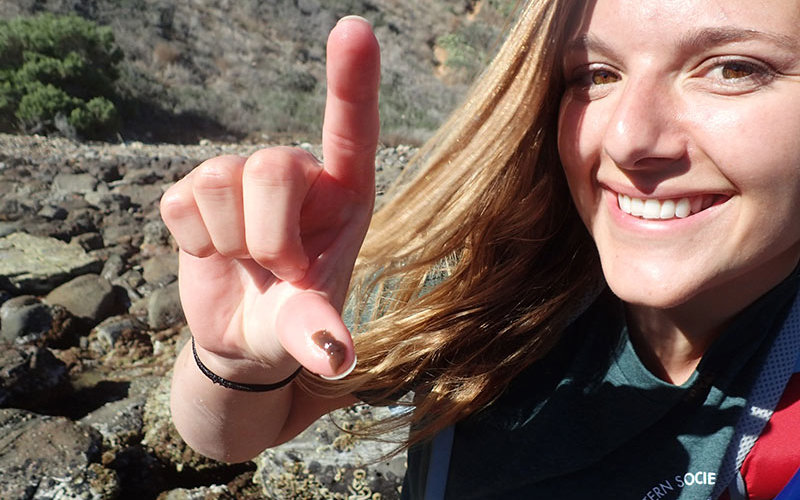
Polyclad flatworms are colorful free-living marine predators that eat various worms, mollusks and even small crabs as they creep and crawl on rocks in coastal environments all around the world.
The science-fiction-like sea creatures are slim, often one-inch or smaller, and their colorful bodies — from yellow to blue, green, orange, purple and pink — have captivated student researcher Kelsey Nannini.
Her research efforts have resulted in the first DNA barcode survey of broad polyclad species diversity along California’s coast, and also the first study of this type in the world, said Douglas Eernisse, professor of biological science and Nannini’s faculty adviser.
The study about the little-known marine animal also is contributing to the encyclopedia of life — a collaborative encyclopedia of living species known to science.
Biologists have learned that nearly all animal species have their own characteristic DNA sequence of a particular gene, known as COI, and once characterized, this unique COI sequence can then serve like a “barcode” for future species identifications, Eernisse explained.
“There are now nearly 200,000 animal species with such barcodes available, but few polyclad flatworm barcodes, and none yet from California — until now,” Eernisse said.
“Their ecological importance is definitely underappreciated, and there are many discoveries waiting to be made as outstanding subjects for the study of reproductive behavior, animal mimicry, toxins and warning coloration, just to mention a few topics that involve polyclads.”
Nannini, who is pursuing a bachelor’s degree in biological science with a concentration in ecology and evolutionary biology, noted that the research experience and her faculty mentor have fueled her interest in a research career in marine biology.
“I hope my research inspires others to get out and explore the natural world and learn something new about the amazing animals whom we share it with.”
Why should we care about flatworms and are they really flat?
Polyclad flatworms are marine worms that live in coastal waters all over the world. There are over a thousand species in existence, and many of them exhibit brilliant colors and patterns. Polyclad flatworms may not be vitally important to human survival, but our discoveries could ultimately lead to an increase in our knowledge of the natural world around us. They are impressively flat with only their body cavity being used for digestion of prey. When they swim, they glide through the water revealing their bodies and showing off their beautiful colors.
What is the focus of your research?
For the project, we collected flatworm specimens from many intertidal sites around Southern and central California. The specimens were then identified by experts and then used to test the newly created polyclad-specific primers. Since these new primers were successful, we then used them to generate the first DNA barcodes for polyclad flatworm species found on the coast of California.
Why is this research important?
This research provides ecologists, physiologists and reproductive biologists a method for flatworm identification for future comparative studies. Our regional pilot study for Southern and central California also provides DNA barcodes that are useful in new species descriptions for this little-explored group of intertidal predators. While many other animal groups have been extensively studied, this work opens up new doors for future studies to be done on this lesser known group of animals. The goal of creating a complete ‘encyclopedia of life’ cannot be completed if there is an entire group left out of the big picture.
What is most biologically fascinating about flatworms?
Flatworms are incredibly fascinating because they are a group of animals that are so diverse, yet they get very little attention. After universal DNA barcoding primers were made available in the 1990s, researchers began to generate barcodes for species in many animal groups, such as mammals, reptiles, fish and mollusks. Flatworm species, however, were unable to be barcoded because of a mismatch between the primers and the corresponding gene region on the animals. They were mostly left out of the effort to create an ‘encyclopedia of life’ using these DNA barcodes. I enjoy working on a group of animals that is underappreciated by most, yet biologically fascinating in so many ways.
Any fun facts about flatworms?
Flatworms are hermaphroditic and participate in an interesting mating ritual known as penis fencing. During this event, one flatworm attempts to inseminate the other — without getting inseminated itself. This behavior can last up to an hour, and the loser of this battle immediately begins collecting the necessary resources for egg development.